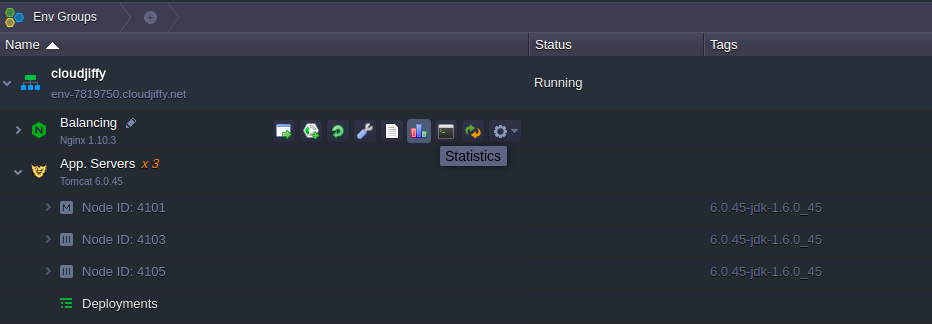Statistics Monitoring at Apiqcloud
View Statistics
You can track the usage statistics for all the nodes in your environment: application servers, balancers, web servers, and databases. For that, just click the corresponding button next to the desired instance (or set of the same-typed ones):

In the opened tab you’ll find the statistics on all the types of consumed resources and their limits:
- RAM - memory consumption (in Mb)
- CPU - processor load (in MHz)
- Network - internal and external traffic (in Mb)
-
Disk - stored data amount (in Mb) and I/O operations amount (in IOPS)
Herewith, the RAM and CPU limits depend on the number of cloudlets you’ve allocated for a node, while the Network, Disk and IOPS ones are defined by your hosting provider.
You can further analyze the presented statistics by varying the interval and duration settings and enabling/disabling the particular sections at the top tools panel:

Tip: hover over the desired graph to get detailed information for a particular time frame.
Using the statistics data you can easily track the resources consumption of your application, thus analyze and predict your future spends and, as a result, be able to choose the best way to manage your environment. For even more convenience, you can configure the set of load alerts to be notified about the consumption level growth or wane to the specified percentage via email. This can greatly help you to save your money!
To get an additional information on resources charging, see the corresponding document.
And below we’ll consider the specifics of I/O usage tracking in more details.The Input/Output Operations per Second amount monitoring is the very common and popular storage measurement method, which helps to analyze the container’s efficiency based on its ability to handle a particular number of reading and write operations simultaneously without the performance degradation.
Note that currently IOPS statistics for the Windows-based nodes is not provided.
1. IOPS data is shown within the Disk statistics section by means of the second axis to the right of the graph (we’ve disabled all the rest of sections to concentrate on the information we are actually interested in):

Obviously, the more operations are handled - the higher the system load is. Thus, to avoid the hardware efficiency degradation, the allowed IOPS amount is limited - the appropriate threshold (defined by your hosting provider) is marked with the red dotted line at the top of the graph.
Reaching this point implies that the performance of your container can be negatively affected, so it is needed to enlarge the number of servers used or to optimize the application itself.
2. Upon hovering over the particular point at the Disk/IOPS graph, you’ll see the popup tooltip with the following details:

- date and time of the gathered stats
- Disk - the amount of space container is actually using
- Disk space limit - the maximum amount of data that is allowed to be stored in a container
- IOPS - the number of I/O operations handled during the stated Interval
- IOPS limit - the maximum number of I/O operations, allowed to be performed by the container during the stated Interval
3. As it was mentioned above, the IOPS limit depends on the Interval chosen. So, for example, if you state 1-hour Interval for your environment, the prior limit for 1 minute (which is equal to 6000 - see the image in the previous step) will be increased in 60 times (as 1 hour = 60 minutes):
6000 * 60 = 360 000

In such a way, you are provided with the actual disk load information and get the ability to monitor its state in real time.

